
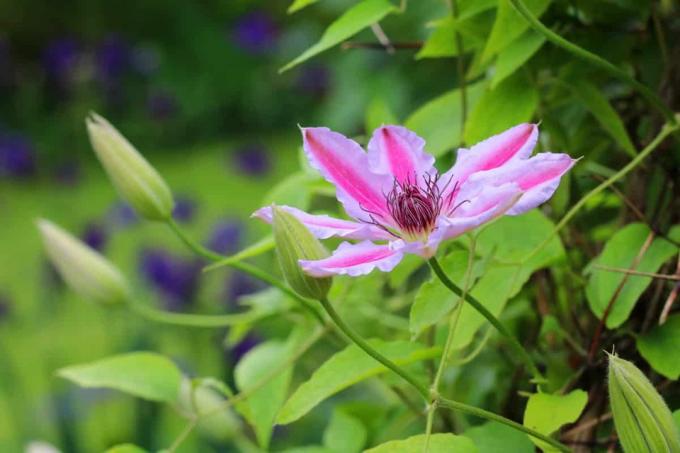
Table of contents
- slugs
- aphids
- clematis fly
- spider mites
- vine weevil
- May and June beetles
- wireworms
Clematis is rarely attacked by pests, but when an infestation does occur, the consequences can be dramatic. Especially in years when pests such as snails and voles find too few other sources, the clematis is not safe from them.
slugs
Slugs are the most common enemy of every gardener and they are also responsible for most of the damage to clematis. However, the plants are only particularly endangered in two phases, which means that you can also take good precautions at these times.
Pay special attention to snails at:
- new plantings
- above-average warm and humid weather during shoot formation
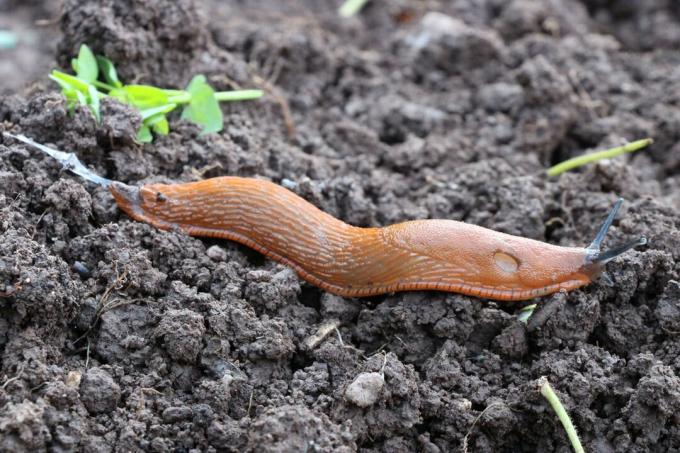
You can easily protect new plantings with a snail fence. Once the plant has rooted itself well in the ground, it can recharge its batteries and develop strong leaves. Older leaves and shoots are usually no longer interesting for the snails. It is more difficult to protect large plants during shoot formation in spring. I often no longer put up a snail fence around large perennials. In this case, it becomes a bit more tedious because you have to collect the animals.
To do this, proceed as follows:
- Lay boards around the clematis
- look for snails under the boards several times a day
- in the evening also search the plants with a flashlight
A notice:
Snails on the clematis are usually only a temporary problem for the plant. Therefore, you should only resort to chemical agents such as slug pellets in the event of a massive infestation.
aphids
Aphids are a clematis problem that can crop up throughout the season. However, it is difficult to examine the climbing plants for an infestation. However, you should watch for signs such as stunted growth or shedding closed buds or buds. Watch out for yellow leaves as these could be signs of a first infestation. It becomes very clear when the leaves are shiny and sticky from honeydew, because the aphids secrete. Aphids become a problem, especially in dry periods.
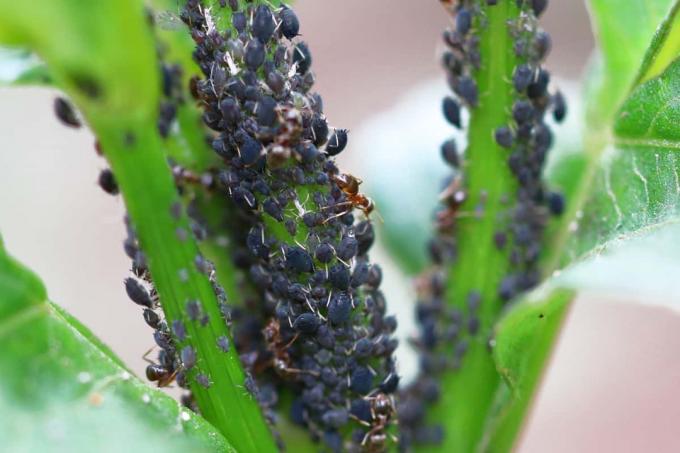
Simple home remedies
- Spray the plant with a mixture of 100 g of soft soap and 1 liter of water at intervals of several days
- Release beneficial insects such as ladybugs or lacewings
- Plant plants like lavender around the clematis
You should quickly get an infestation by aphids under control. The aphids themselves are less harmful to the clematis, but they damage the plants' epidermis, making it easier for bacteria and fungi to penetrate. Disease tends to have a greater impact on the plant than an infestation of pests, from which it can recover more easily.
clematis fly
A new pest has been observed on clematis for a number of years. called clematis fly. Specifically, this pest is California flower thrips (Frankliniella occidentalis), a fringed-wing species originally from the United States. The term "clematis fly" is not quite correct, because these insects originally specialized in cotton and also caused great damage there. Due to its worldwide distribution, however, it has been shown that it has a wide range of foods, including, for example, strawberry blossoms or the blossoms of the clematis.
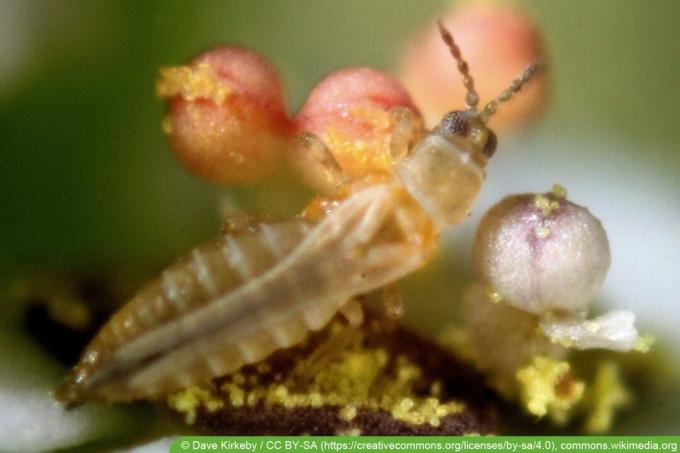
So far it is not quite clear how to deal with this pest. The clematis fly bores holes in the flower from around May and eats the bud from the inside out. On the other hand, the clematis fly is also a predatory insect that eats aphids. It is therefore neither clearly classifiable as a pest nor as a beneficial, which also makes it difficult to deal with. A currently recommended method is that when puncture marks appear, the plant should be severely cut back. The pruning is disposed of in the residual waste. The first blossom does not appear, but the second blossom is usually much less infested.
spider mites
Spider mites, like aphids, appear in warm and dry summer months. The problem is that the small insects are difficult to see with the naked eye. They hide on the underside of the leaves.
You should check the clematis for spider mites if you see the following signs:
- selectively discolored leaves
- curled leaves
- many fallen leaves
A notice:
If the infestation is severe, the spider mites can also be recognized by the fact that they form webs between the leaves.

Controlling spider mites can be a challenge. You can only make life as difficult as possible for the insects:
- Remove infested parts of the plant and dispose of in the residual waste
- Shower clematis at intervals of several days
- Use predatory mites as a biocide
- If the plants are still small, spray the leaves with neem oil
vine weevil
The vine weevil is a pest in the garden that scarcely stops at any plant. Both adult beetles and larvae can harm clematis.
The damage looks like this:
- Growth disorders (often stunted growth)
- semi-circular feeding damage on leaves
- withering leaves
- increased dropping of flowers and leaves

There are only a few ways to fight the vine weevil. The use of nematodes, which are effective in the larval and beetle stages, has proven successful. The insects eat the nematodes and die within two days.
Tip:
Boosting the health of the clematis is an important preventative measure to make it harder for the vine weevil to do damage. To strengthen them, you can, for example, fertilize the plants every few weeks with manure made from field horsetail.
May and June beetles
May and June beetles are often a problem in the garden. However, it is rarely the adult beetles that cause damage; it is usually the larvae, also known as grubs, which eat the roots with their great appetite. The larvae are not very selective when it comes to their food and can also eat the roots of the clematis. Due to the fact that the clematis likes the soil around its roots to be constantly slightly moist, this also attracts the beetle larvae. You should dig up young plants when they are clearly infested, remove all of the soil and place them in a different location.
combat
- reduce soil moisture
- Loosen the soil around the rootstock
- Remove or replace ground cover around the clematis. cut back heavily

In addition, you should encourage predators if there is an increase. These include primarily hedgehogs and birds. Birds can also keep other pests such as aphids or vine weevils at bay. It is important for these beneficial insects that the area around the clematis remains free so that they have easier access to the grubs.
wireworms
Wireworms are light to dark brown larvae of the click beetle. The larvae are called wireworms because their body is so firm and elastic that they cannot be crushed but can be broken up as much as possible. The larvae of the click beetle are also root pests and can damage the clematis considerably. As a rule, the infestation is not so severe that the clematis dies off immediately, a very dry summer together with however, a wireworm infestation can be a situation that clematis finds difficult to cope with without help comes.
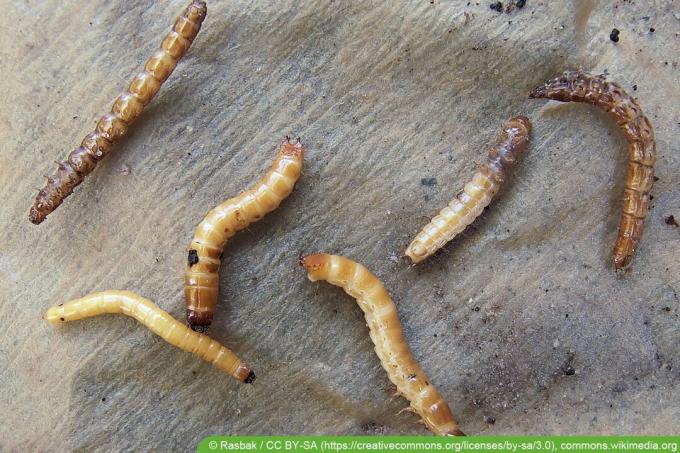
You can catch the wireworms with a simple method:
- Halve potatoes and carrots
- distribute the halved vegetables around the clematis
- check the subpages after a few days
- Remove baits that have wireworms in them and dispose of them in the trash
Tip:
Plant marigolds around the clematis. Wireworms don't like marigolds because the roots are poisonous to them.
 Home editorial office
Home editorial office
Learn more about clematis
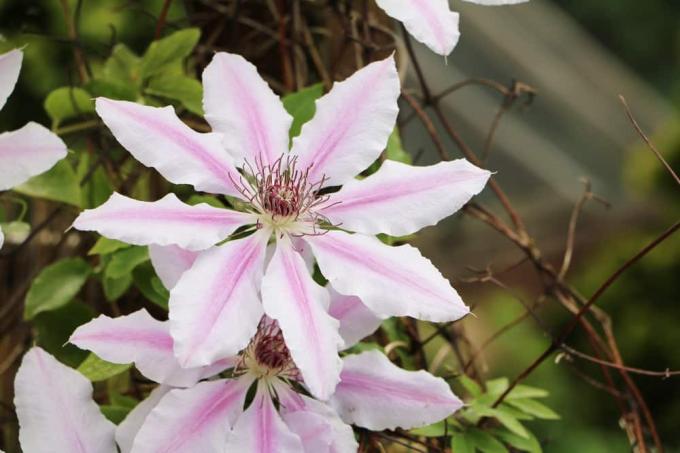
Pruning clematis: Instructions for late and early flowering varieties
Clematis is known and loved for its diverse flower shapes and colors. The plants, also known as clematis, are extremely decorative plants that can be used in many places in the garden to green trellises, pergolas, arbors and walls.

Clematis gets brown leaves - combat clematis wilt
Clematis wilt is a menacing disease that occasionally afflicts clematis. Especially the popular, large-flowered hybrids are being swept away at high speed. Left to its own devices, the clematis is helplessly at the mercy of the fungal pathogen. However, with the help of her owner, she is able to survive.
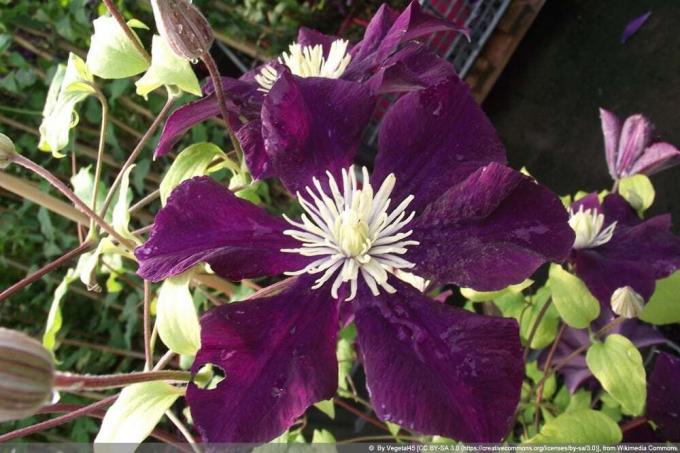
Clematis 'Warszawska Nike' Warsaw Night - care and pruning
The Clematis 'Warszawska Nike' Warsaw Night scores with its flowers. With the easy-care climbing plant you definitely get an eye-catcher in the garden. Only the cut is a bit difficult and requires courageous access. More about this is here.
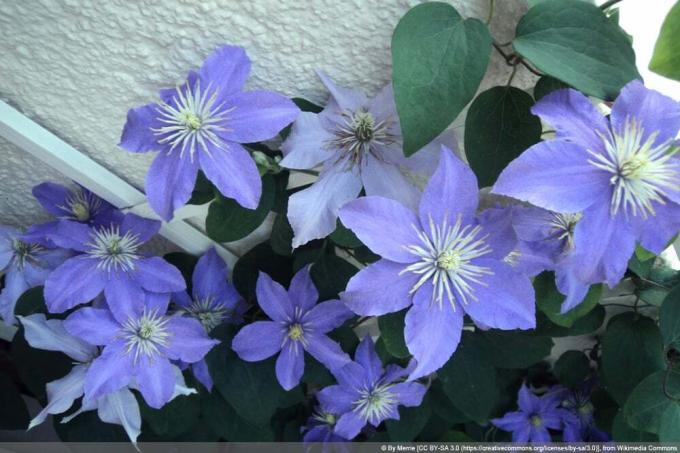
Clematis 'Justa' clematis - profile, care and cutting
Clematis 'Justa' clematis is a dwarf variety that has strong growth. In the summertime, the plant adorns itself with beautiful purple flowers that can also shine light blue. The clematis grows climbing and can reach a considerable height.

Clematis 'Nelly Moser' - pruning and care from A-Z
The clematis 'Nelly Moser' inspires with delicate pink flowers. A strong violet central stripe on each petal and the red stamens add harmonious color accents. In May and June, it unleashes a veritable explosion of flowers. With proper care, it also gives away a second bloom.

Clematis 'Piilu' clematis - profile, care and cutting
Clematis 'Piilu' is a particularly attractive and floriferous representative of the clematis. Its large, plate-shaped flowers captivate with an extraordinary color brilliance in dreamlike pink to violet and a second bloom until September.



